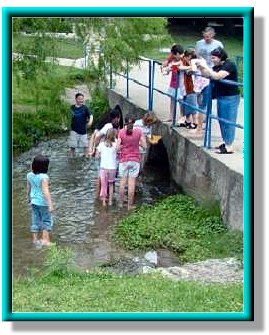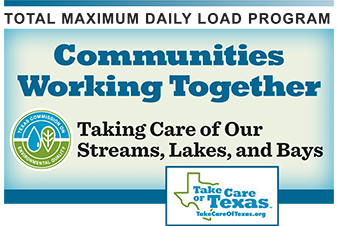Surveying Recreational Uses in Texas
Counties: Newton, Gregg, Hunt, Hopkins, Wood, Rains, Trinity, San Augustine, Wise, Tarrant, Dallas, Johnson, Galveston, Harris, Brazos, Washington, Grimes, Robertson, Leon, Madison, Limestone, Fort Bend, Colorado, Brazoria, Austin, Wharton, Matagorda, Atascosa, Live Oak, Cameron, Hidalgo
Parameter: Bacteria
Basins: Sabine, Trinity, Brazos, Brazos-Colorado Coastal, Nueces, Nueces-Rio Grande Coastal
Segments: 0502A, 0502B, 0505B, 0505G, 0512A, 0512B, 0806E, 0810, 0810A, 0810B, 0810C, 0810D, 0822A, 0822B, 0838C, 0841E, 0841F, 0841G, 0841H, 0841J, 0841K, 0841N, 0841U, 1104, 1113A, 1209, 1209D, 1209E, 1209G, 1209H, 1209I, 1209J, 1209K, 1244, 1245, 1245C, 1245D, 1302, 1302A, 1305, 2107, 2202
On this page:
- Background and Goals
- Evaluating Appropriate Recreational Uses
- Public Participation
- For More Information
Background and Goals
Texas protects the quality of the state's surface waters to make them safe for recreational uses. Pastimes like swimming, wading, or other activities during which a person might ingest natural waters are referred to as the “contact recreation use” in the state's Standards for water quality. Criteria that are also defined in the Standards are used to evaluate the suitability and safety of streams, lakes, and estuaries for contact recreation.
There are four adopted contact recreation use categories in the Standards:
- Primary Contact Recreation
- Non-contact Recreation
- Secondary Contact Recreation 1
- Secondary Contact Recreation 2
For an overview of water quality standards and management, read the TCEQ's publication Preserving and Improving Water Quality.
Evaluating Appropriate Recreational Uses
Recreational use-attainability analyses (RUAAs) are conducted to determine which of the four recreational use categories is appropriate for a particular water body. The first phase of an RUAA is a survey of existing conditions and uses, during which staff collect:
- information on a water body, such as the presence or absence of water recreation activities, stream flow type, stream depth; and
- data on physical conditions in a water body that are necessary for completing the analysis.
The TMDL Program surveyed numerous water bodies in Texas from 2009 through 2011 The TCEQ Standards team will complete the second phase, the analysis, and then make recommendations for revising standards to the commission based on the results. See the procedures for conducting RUAAs.
The surveys for all the segments in this project have been completed. See survey reports on our webpage Recreational Use Attainability Analyses, where you may find RUAAs by looking under the associated river or coastal basin.
Public Participation
The TCEQ actively seeks the participation of local stakeholders. Staff informed the public about this project through meetings, and with notices in print and electronic media. All meetings were open to everyone.
The TMDL Program shared the survey plans with the public, and residents had the opportunity to change the plans based on their local knowledge and expertise. Several stakeholder meetings were held at locations around the state during the course of this survey project.
For More Information
Please email tmdl@tceq.texas.gov, and mention the Texas RUAA project in the subject line. Or call us at 512-239-6682.
To learn about the status of the use attainability analyses, please visit the webpage Recreational Use Attainability Analyses. You may also email TCEQ Standards Group or call them at 512-239-6682.





 Back to top
Back to top